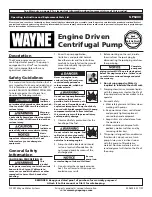
21
en
8. Care and maintenance
Unplug the supply cord from the electric socket.
8.1 Care of blades
●
Used saw blades should be cleaned to remove resin
deposits at regular intervals as clean blades achieve
a higher cutting performance. Resin deposits can be
removed by placing the saw blades in a bath of paraf-
fin (kerosene) or commercially available resin remover
for 24 hours.
8.2 Care of the tool
●
The tool was lubricated adequately when it was man-
ufactured. After long periods of heavy use it is rec-
ommended that the tool is inspected and serviced at
a Hilti workshop. This will increase the life expectan-
cy of the tool and avoid unnecessary repair costs.
●
Repairs to the electrical section of the tool may be car-
ried out only by a trained electrical specialist.
-CAUTION-
Keep the power tool, especially its grip surfaces, clean
and free from oil and grease. Do not use cleaning agents
which contain silicone.
The outer casing of the tool is made from impactresis-
tant plastic. Sections of the grip are made from a syn-
thetic rubber material. Never operate the tool when the
ventilation slots are blocked. Clean the ventilation slots
carefully using a dry brush. Do not permit foreign objects
to enter the interior of the tool. Clean the outside of the
tool at regular intervals with a slightly damp cloth. Do not
use a spray, steam pressure cleaning equipment or run-
ning water for cleaning. This may negatively affect the
electrical safety of the tool.
8.3 Maintenance
Check all external parts of the tool for damage at regular
intervals and check that all controls operate faultlessly.
Do not operate the tool if parts are damaged or when the
controls do not function faultlessly. If necessary, your
electric tool should be repaired at a Hilti repair center.
Repairs to the electrical section of the tool may be car-
ried out only by trained electrical specialists.
8.4 Checks after care and maintenance
After care and maintenance, check that all protective
devices are fitted and that they function faultlessly.
4. Hold the tool securely and press the on / off switch.
5. Press the tool firmly against the workpiece and begin
the plunge movement by reducing the angle between
the baseplate and the workpiece.
6. Once the blade has penetrated the workpiece, bring
the tool into the normal working position (with the
entire baseplate surface in contact with the work-
piece).
7. Continue sawing along the cutting line.
Printed: 07.07.2013 | Doc-Nr: PUB / 5138188 / 000 / 00




































